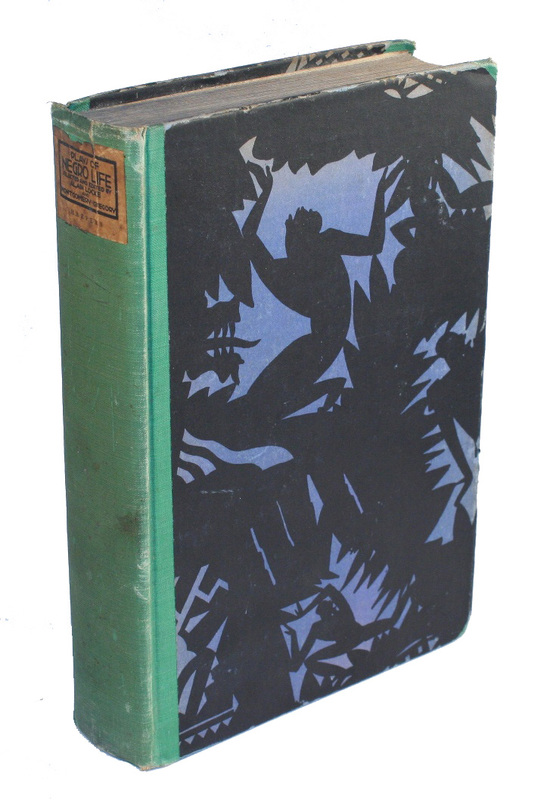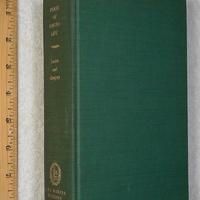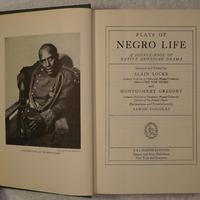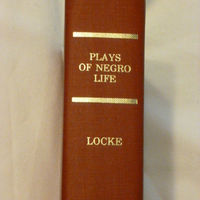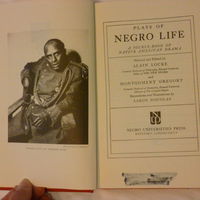-
Title
-
Plays of Negro Life: A Sourcebook of Native American Drama
-
This edition
-
"Plays of Negro Life: A Sourcebook of Native American Drama" . Ed. Alain Locke and Montgomery Gregory. Illus. Aaron Douglas. New York: Harper, 1927. 430 pp.; repr. 1969.
-
Other editions, reprints, and translations
-
• Repr. (?) with subtitle: "Twenty Plays of the Contemporary Negro Theater."
-
Table of contents
-
Introduction: The drama of Negro life, by Alain Locke -- Thelma Duncan, The Death Dance – Georgia Douglas Johnson, Plumes – John Matheus, 'Cruiter – Richard Bruce (Nugent), Sahdji, An African Ballet – Willis Richardson, The Broken Banjo – Willis Richardson, The Flight of the Natives – Eulalie Spence, The Starter – Jean Toomer, Balo – Frank H. Wilson, Sugar Cane – E. H. Culbertson, Rackey – Paul Green, In Abraham's Bosom – Paul Green, The No' Count Boy – Paul Green, White Dresses – Eugene O'Neill, The Dreamy Kid – Eugene O'Neill, The Emperor Jones – J. W. Rogers, Jr., Judge Lynch – Ridgley Torrence, The Danse Calinda – Ridgley Torrence, Granny Maumee – Ridgley Torrence, The Rider of Dreams – Lucy White, The Bird Child. A chronology of Negro theatre, by M. Gregory. – Bibliography of Negro Drama, by Alain Locke.
-
About the anthology
-
• Includes works by African American authors and non-African American authors.
• [Jacket flap advertisement in Countee Cullen's "Caroling Dusk" (Harper, 1927): "Plays of Negro Life" is described as:
"The first definite collection of contemporary drama of negro life is a source book of an increasingly important aspect of native American drama. The anthology is edited by the sponsors and former directors of a negro laboratory theater group at Howard University, and contains the worth-while repertoire of the negro theater to date. Such notable general contributions as 'Granny Maumee,' 'In Abraham's Bosom' (the Pulitzer Prize play), and 'The Emperor Jones' are included, as well as plays by negro playwrights. The book is designed as a manual for drama study groups and amateur dramatic organizations as well as for the general reader and those especially interested in this significant and rapidly-advancing field of our national drama." (New York Public Library Digital Collections https://digitalcollections.nypl.org/items/510d47db-d0e1-a3d9-e040-e00a18064a99#/?uuid=510d47db-d0e1-a3d9-e040-e00a18064a99 )
-
Reviews and notices of anthology
-
• n/a
-
Commentary on anthology
-
• "The detailed chronology by Gregory and the bibliography by Locke are both // valuable" (Kinnamon 1997: 474-75).
-
• "At that time, 1923, [Alain] Locke and [Montgomery] Gregory were setting up Howard's Dramatic Club, later called the Howard University Players. By 1925 they had begun discussions about the possibility of publishing a collection of plays on African American life. Their plans became a reality in 1927 with the publication of 'Plays of Negro Life.' This collection, similar to 'Plays and Pageants' published three years later, is regarded as an important step in the New Negro Renaissance. Not as widely known as his anthology 'The New Negro,' 'Plays of Negro Life,' its counterpart, contained twenty plays in a genre in which, according to Du Bois, blacks were thought to be 'especially gifted.'
"The Locke anthology of plays is often considered the first anthology of black drama. Actually, the Woodson-Richardson anthology ["Plays and Pageants"1930] has this distinction, for 'Plays and Pageants' contained only plays written by African Americans, whereas half of the plays in Locke's anthology were written by whites. Plays by Paul Green, Eugene O'Neill, and Ridgely Torrence were mixed with works by Richardson, Georgia Johnson and Frank Wilson. It was as though Locke thought the volume needed the white playwrights in order for this volume to be considered valuable. In his introduction to 'Plays of Negro Life,' Locke explained his collection's dependence on white playwrights by pointing to them as the 'advantaged rival' of the black playwright; the white playwright, he wrote, had a 'natural objectivity toward the material of the race life' (Introduction). Additionally, unlike the Woodson-Richardson anthology, Locke's was published by a white firm, Harper and Brothrs, who may have urged the inclusion of plays by whites. Furthermore, Locke's plays had a different purpose than those in the Woodson-Richardson collection. Locke's were not meant to educate, at least not as explicitly, as were those published in 'Plays and Pageants.' Owing to the difference in intended audience and reader, the topics of the two anthologies differ. The plays in Locke's book often have whites cast as the antagonists or opponents, undermining black goals, whereas in 'Plays and Pageants' little mention is made of whites. Instead, the plays, having been collected for students, were designed to instill racial pride rather than racial difference and tension" (Christine R. Gray. "Introduction." "Plays and Pageants from the Life of the Negro." Ed. Willis Richardson. [1930]. Jackson: UP of Mississippi, 1993. xxiv-xxv).
-
See also
-
• Stein, Rivka. "Illustrations for "Plays of Negro Life"." "Book Artists and Their Illustrations" 20 Oct. 2015. Web.
-
Quora.com
-
Cited in
-
• Lash 1946: 724.
• Rowell 1972: 63.
• Hatch 1991: 189.
• Kinnamon 1997: 474.
-
Item Number
-
A0025
